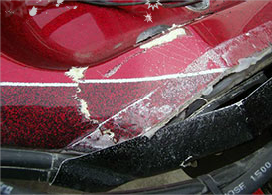Minnesota Boat Repair | Collision Boat Repair
Clean, Drain and Dry Your Boat
Continued from Part 2
One Last Reminder – Is the Drain Plug In?
Invasive species regulations are now in effect in many states and many of them (including Minnesota), now require boaters to remove the plug and drain the bilge and live well before transporting a watercraft. In this Basic Boating Safety Course there is an extensive section on trailering and one of the things that is emphasized is to make sure the drain plug is in before launching your boat.
The majority of recreational boats in the United States are trailered to and from the water. Your boat trailer is only one part of the entire boating package, which includes the boat, trailer, hitch and towing vehicle. Neglecting the trailer’s maintenance can result in damage to your boat, your towing vehicle or both.
Ranger discovered very early that most boats spend more time on their trailers than in the water. Experience also proved that ill-fitting boat trailers actually damage a boat’s hull and running surfaces over time. Below is our check-list for launching.
Launching
- Do initial launch preparations away from the ramp so as not to impede launching for others.
- Raise the outdrive or motor, remove the support bracket and install the drain plug.
- Disconnect the trailer wiring. Remove tie down straps and again check the drain plug.
- Make any equipment adjustments necessary and check the drain plug.
- Connect the fuel tank, check fluid levels and check the drain plug.
- Drive to the ramp and back the boat and trailer down the ramp, keeping the tow vehicle’s wheels out of the water.
- Set the emergency brake, shift into Park, and block the wheels.
- Someone should get aboard the boat, turn on the blower, lower the motor, look for water entering the boat, (in case you forgot to check the drain plug) sniff the bilge and start the motor.
- Make sure you have attached a bow line to the boat, then release the winch and disconnect the winch line.
- You should be able to launch the boat with a slight shove or by backing the boat off the trailer under power.
- Return the towing vehicle to the parking lot as soon as the boat is launched so the next person in line may proceed.
- Move the boat to an area away from the ramp to load additional equipment and passengers.
Did we say… Make sure the drain plug is in?
While we can’t avoid all dangers on the water, staying alert can help keep you safe. After all, the earlier you see a hazard, the more time you have to respond to the problem. Speeding, driving distracted, drinking and exhaustion can all greatly reduce your reaction time, making you far more likely to be involved in a boating accident.
Slow Down!
 Boats are bigger and faster than ever. Just because your watercraft can go 70-plus mph doesn’t mean it should be operated that fast. Slowing down increases your odds of seeing people and objects in the water, sandbars and other hazards. It also increases your general awareness of what’s going on around you.
Boats are bigger and faster than ever. Just because your watercraft can go 70-plus mph doesn’t mean it should be operated that fast. Slowing down increases your odds of seeing people and objects in the water, sandbars and other hazards. It also increases your general awareness of what’s going on around you.
Collision with a fixed object” is second most common type of recreational boating accident. Hitting an object under water that you didn’t know was there can do some serious damage to your beloved boat! So, keeping a watchful eye can help you to avoid collisions with other skiers, swimmers, boats, watercraft and yes… with foreign objects. Remember… rocks aren’t chartered!
Boat Repairs, Renovations & Refinishing
Of course, whether you’re researching a new boat, or are a seasoned Captain, some accidents are completely unavoidable no matter how well you drive. Maybe you’ve scratched the metal flake on your new boat, or have a few battle scars on the fiberglass or aluminum boat you’ve had for years.
Metal-flake Refinishing
This boat was hit by a car; the port side and transom motor were crushed. We repaired both the motor and boat to perfect, pre-accident condition.
Even though the damage to your boat may seem to be self-repairable, we advise you to seek the assistance of our expert technicians. This is because on many occasions damage that appears to be simple on the surface may be much more serious in nature.
Anchor Marine Repair is #1 in Minneapolis boat repair. We perform fiberglass repair, metal flake repair, and aluminum boat repair for collision, structural, and storm damaged boats.




